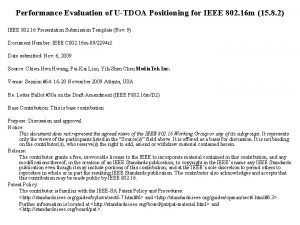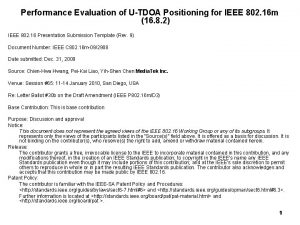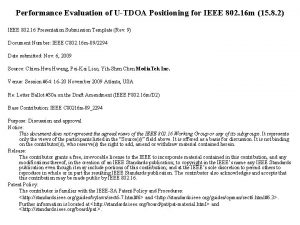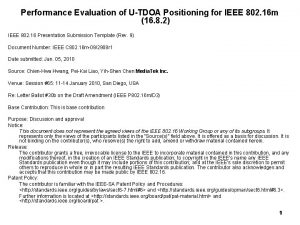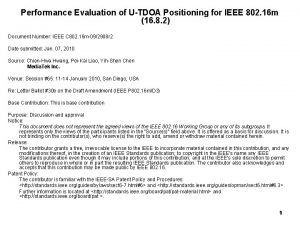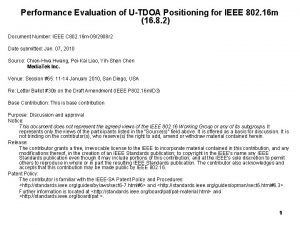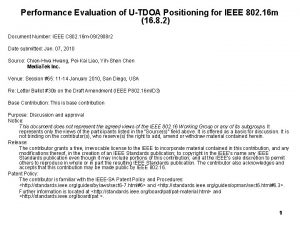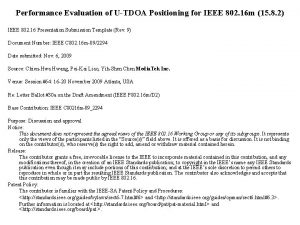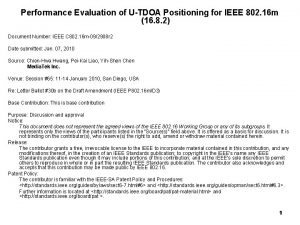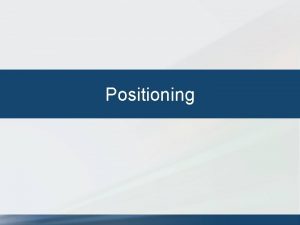Performance Evaluation of UTDOA Positioning for IEEE 802

![Introduction • Performance of D-TDOA positioning was evaluated in [1] in Hawaii, USA (IEEE Introduction • Performance of D-TDOA positioning was evaluated in [1] in Hawaii, USA (IEEE](https://slidetodoc.com/presentation_image_h2/b035eac723c912a49d8e1b21dcfccb2e/image-2.jpg)









![References [1] IEEE C 80216 m-09/2086, “Evaluation of D-TDOA Positioning” [2] IEEE P 802. References [1] IEEE C 80216 m-09/2086, “Evaluation of D-TDOA Positioning” [2] IEEE P 802.](https://slidetodoc.com/presentation_image_h2/b035eac723c912a49d8e1b21dcfccb2e/image-12.jpg)
- Slides: 12

Performance Evaluation of U-TDOA Positioning for IEEE 802. 16 m (15. 8. 2) IEEE 802. 16 Presentation Submission Template (Rev. 9) Document Number: IEEE C 802. 16 m-09/2294 Date submitted: Nov. 6, 2009 Source: Chien-Hwa Hwang, Pei-Kai Liao, Yih-Shen Chen Media. Tek Inc. Venue: Session #64: 16 -20 November 2009 Atlanta, USA Re: Letter Ballot #30 a on the Draft Amendment (IEEE P 802. 16 m/D 2) Base Contribution: IEEE C 80216 m-09_2294 Purpose: Discussion and approval Notice: This document does not represent the agreed views of the IEEE 802. 16 Working Group or any of its subgroups. It represents only the views of the participants listed in the “Source(s)” field above. It is offered as a basis for discussion. It is not binding on the contributor(s), who reserve(s) the right to add, amend or withdraw material contained herein. Release: The contributor grants a free, irrevocable license to the IEEE to incorporate material contained in this contribution, and any modifications thereof, in the creation of an IEEE Standards publication; to copyright in the IEEE’s name any IEEE Standards publication even though it may include portions of this contribution; and at the IEEE’s sole discretion to permit others to reproduce in whole or in part the resulting IEEE Standards publication. The contributor also acknowledges and accepts that this contribution may be made public by IEEE 802. 16. Patent Policy: The contributor is familiar with the IEEE-SA Patent Policy and Procedures: <http: //standards. ieee. org/guides/bylaws/sect 6 -7. html#6> and <http: //standards. ieee. org/guides/opman/sect 6. html#6. 3>. Further information is located at <http: //standards. ieee. org/board/pat-material. html> and <http: //standards. ieee. org/board/pat >.
![Introduction Performance of DTDOA positioning was evaluated in 1 in Hawaii USA IEEE Introduction • Performance of D-TDOA positioning was evaluated in [1] in Hawaii, USA (IEEE](https://slidetodoc.com/presentation_image_h2/b035eac723c912a49d8e1b21dcfccb2e/image-2.jpg)
Introduction • Performance of D-TDOA positioning was evaluated in [1] in Hawaii, USA (IEEE Session #63. 5). • This document defines some specific assumptions required for U-TDOA based positioning evaluation and presents simulation results for U-TDOA positioning that were obtained with specified assumptions • This contribution is compliant with the latest version of IEEE 802. 16 m/D 2 [2]

Motivation • One of the most powerful ways to personalize mobile services is based on location. One of the most obvious technologies behind location based service (LBS) is positioning • Strict requirements on user positioning accuracy are imposed on existing location services such as wireless Enhanced 911 and new upcoming services • It is imperative to verify whether IEEE 802. 16 m network is able to meet the positioning accuracy requirements

IEEE 802. 16 m SRD - LBS Performance Requirements • According to IEEE 802. 16 m SRD [3], IEEE 802. 16 m systems should provide support for LBS. IEEE 802. 16 m systems should satisfy the requirements in the following table LBS Requirements Feature Requirement Location determination latency < 30 s Handset-based position accuracy (in meters) 50 meters (67%-tile of the CDF of the position accuracy) 150 meters (95%-tile of the CDF of the position accuracy) Network-based position accuracy (in meters) 100 meters (67%-tile of the CDF of the position accuracy) 300 meters (95%-tile of the CDF of the position accuracy) Comments Need to meet E 911 Phase II Requirements

Description of TOA Estimation Algorithm • A format 0 non-synchronized ranging signal is used by the AMS • The code index of the Zadoff-Chu sequence adopted by the AMS is known to the serving and neighbor ABS’s • The block diagram of TOA estimation is shown in the figure below Rx Signal LPF RCP Removal RCP: Ranging Cyclic Prefix FFT Extraction of Ranging Code Zero Padding Ranging Code IFFT Peak Test Obtain Timing

Simulation Assumptions • • • • 3 ABS’s (1 serving ABS + 2 neighbor ABS’s) form an equilateral triangle with a side length of 1. 5 kilometers Carrier frequency: 2. 5 GHz Carrier bandwidth: 10 MHz FFT size: 1024 CP ratio: 1/8 Number of OFDM symbols per subframe: 6 P 802. 16 m/D 2 non-synchronized ranging channel, format 0 1 Tx antenna, 2 Rx antennas Modified ITU Pedestrian B Channel, velocity: 3 km/hr One other user is doing ranging in the same subband with probabilities 1, 0. 333, 0. 1 Other subcarriers (besides subcarriers for ranging) are transmitting data Positioning algorithm: TDOA Distance-dependent pathloss: L (in d. B) = 128. 1+37. 6 log 10 R (R in km) The power of AWGN is 10 d. B less than the power of intercell interference Frequency reuse factor = 1 Frames of serving and neighbor ABS’s are synchronized

Sources of Interference Neighbor ABS Serving ABS • The serving and neighbor ABS’s suffer from – AWGN – Intracell interference: interference exists because subcarrier orthogonality cannot be maintained when non-synchronized ranging signal is used – Intercell interference – Another user in the serving cell is doing periodic/aperiodic ranging with a certain probability

Simulation Results • Collision probability is defined as the probability that another user in the serving cell is doing periodic/aperiodic ranging • One or two times TOA estimates are executed to perform U-TDOA positioning • SIR is fixed as 5 d. B; AWGN power is 10 d. B less than interference power

Simulation Results: 1 TOA Estimate

Simulation Results: 2 TOA Estimates

Conclusion • During the execution of LBS, there may be other users in the same cell doing periodic/aperiodic ranging. This degrades the performance of positioning • Intracell interference due to loss of orthogonality when sending ranging signals and intercell interference from neighboring cells also deteriorate the performance • The ranging channel based U-TDOA positioning is NOT able to meet strict Enhanced 911 Phase II requirements in above-mentioned interference limited multipath environment
![References 1 IEEE C 80216 m092086 Evaluation of DTDOA Positioning 2 IEEE P 802 References [1] IEEE C 80216 m-09/2086, “Evaluation of D-TDOA Positioning” [2] IEEE P 802.](https://slidetodoc.com/presentation_image_h2/b035eac723c912a49d8e1b21dcfccb2e/image-12.jpg)
References [1] IEEE C 80216 m-09/2086, “Evaluation of D-TDOA Positioning” [2] IEEE P 802. 16 m/D 2. “DRAFT Amendment to IEEE Standard for Local and metropolitan area networks—Part 16: Air Interface for Broadband Wireless Access Systems—Advanced Air Interface” / 2009 -10 -14 [3] IEEE 802. 16 m-07/002 r 9, “IEEE 802. 16 m System Requirement Document (SRD)”/ 2009 -09 -24













